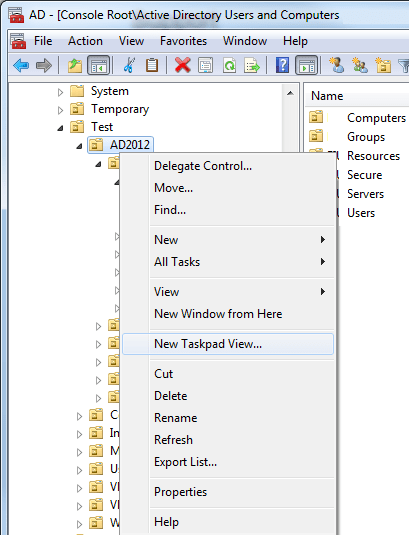Borrowing from the AD best practices video that I shared with you last week, this post will walk through the process of creating taskpad views in your Active Directory Users and Computers MMC snap-in. Taskpad views are a collection of commands adjacent to your list of Active Directory objects. The magic comes from being able to use the user and computer accounts as variables in the commands such as being able to quickly remote desktop a computer or access its C$ share.
This is going to start off after you have an MMC console set up for viewing AD Users and Computers, if you’re not there yet, consult the previous article Adding Active Directory Users and Computers in Windows 7. You can create a TaskPad on an OU but in my limited experience, this seems to work even better when attached to a Saved Query. To create a TaskPad View, right-click on the OU or Saved Query (like “All Computers” or “Stale Users”) that you have decided to use and choose ‘New Taskpad View…’.
A simple wizard will pop up and walk you through the process of configuring the Taskpad how you want…
…including style,
…where it applies,
…and how to name and describe it.
Once the Taskpad View wizard completes, you can leave the box checked to launch the ‘New Task Wizard’. This will go into adding the tasks to the side panel.
There are three options for types of commands to run. The Menu commands are useful for running commands normally found in the MMC shell. Shell commands can use any command that accepts a parameter to pass along the account information.

A menu command like ‘Refresh’, ‘Find…’, or ‘Properties’ just places them in a location that may be more accessible and convenient.

Shell commands get interesting and there is a lot of potential here. For example, to remote desktop to a computer, I would click the computer I want to reach and the Remote Desktop task. That command is made up of Command: Mstsc.exe Parameters: /v: To point the variable at the parameter, just click the arrow pointing right and select ‘Name’. This will insert in the variable name like <COL1>.
From there, it gets to the simple things like choosing the task’s corresponding icon and naming/describing the task.
You can create, edit, and delete taskpad views from your MMC console by right-clicking on the OU/Saved Query where you have the Taskpad view saved. The context menu will now also have an ‘Edit taskpad view…’ and ‘Delete taskpad view…’ option. You can modify the tasks you make, so you can come back and correct them or add new functionality if you come up with a better idea later. Partnered with PS Tools from Microsoft, you can have some powerful tools conveniently at your fingertips, able to reach across the network and easily run frequently used commands with a click. Some commands that might be a good place to start:
- Refresh
- Find
- Remote Desktop
- Properties
- Group Policy Update
- Computer Details
- Add to a group
- Assign Computer
- Computer management Console
- Offer remote assistance
- Open C$
- Remote Command Prompt
- Interactive PowerShell Session
- User & IP info
- Manage PC tool
- Create Computer
- Reset Account
- Reboot Computer

The taskpad views you create are saved in the .mmc console that you create, so be sure to save your changes when you are done. This also allows you to save the console and distribute it to your co-workers and fellow AD administrators.









